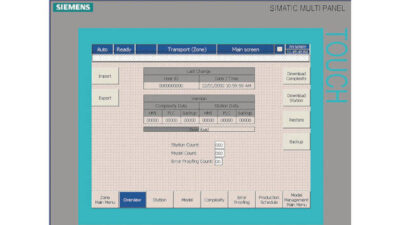Most business executives see IT as a bit of a black hole. The shifting sands of new technologies make it difficult to understand what should be invested in next. Making the wrong technology investment choices—or even stalling when the time comes—can cause a downward spiral that eventually affects the entire enterprise.
Most business executives see IT as a bit of a black hole. The shifting sands of new technologies make it difficult to understand what should be invested in next.
Making the wrong technology investment choices—or even stalling when the time comes—can cause a downward spiral that eventually affects the entire enterprise.
And as businesses seek to wire together complex supply chains, every IT action had better be a good one. But that mandate may be more insidious than it seems on the surface. At the end of 2005, Boston-based AMR Research polled IT pros for their biggest challenges in managing systems. The responses cite integration, response times, and sheer cost. Clearly, most IT organizations would agree that gaining better visibility and control over their planning processes would help IT make better investment decisions.
Systems management issues cited by IT professionals as being among their greatest challenges include integration, response times, and sheer cost.
One example is very telling. When we analyzed one manufacturer’s IT budget, we found its overall spending for IT was consistent with industry benchmarks, but that the company spent 82 percent on operating expenses, leaving a slim 12 percent for capital spending. The budget was heavily weighted toward keeping the lights on, containing limited capital funding and underinvestment in future capabilities. Yet the company competes in an industry where capital spending averages 33 percent, so it was not only behind competitors, but it was positioned to watch them pull away as the technology gap grows.
IT leadership didn’t realize that the great majority of IT work was being performed on applications that had limited impact on the business, and should have been reviewed for retirement, not continued investment (see graphic, Existing application portfolio review ).
The right places to spend
IT organizations are constantly tasked with doing more work than their resources allow. Manufacturing execs are continually examining ways to get closer to customers, reduce costs, and improve competitiveness.These business issues often collide with diverse application landscapes that are often poorly integrated and difficult to maintain.
A proper portfolio review examines legacy systems to consider continued systems investment or eventual retirement of systems that no longer provide clear value.
This matters now that many companies finally have a good ERP backbone in place, and the specter of large and expensive upgrades must be balanced with the possibility of quick-hit application add-ons. Likewise, many necessary capabilities with seemingly little positive impact on performance—e.g., regulatory compliance initiatives, global integration, and technology upgrades—must find the right place in the hierarchy of IT spending.
Companies must maximize the impact of two scarce IT resources—money and talent—on the business, because when done well, this can generate high returns on existing processes and new business ventures.
The method of choice, for CIOs and business execs alike, is portfolio management. IT portfolio management actually has its roots in precedents like Boston Consulting Group ‘s portfolio matrix, which sorted business units into Cash Cows, Stars, Question Marks, and Dogs. Based on a similar line of thinking, IT portfolio management assesses the impact of existing IT activities, and provides tools to assess the value of future IT investments. For IT professionals, this brings visibility and rigor to the review and planning processes. Portfolio management also adds a refreshing level of control and decision consistency lacking in many shops.
Portfolio basics
Managing IT investments as a portfolio yields these types of benefits:
Visibility into where money is being spent, which ultimately provides the baseline to measure value creation;
Prioritization of projects across multiple dimensions, including value to the business, urgency, and financial return—typically among the major upsides for future planning; and
A mechanism to ensure that investments map directly to business objectives, which for many CIOs is the next great frontier.
Portfolio management does that by analyzing two main areas:
Future-based application rationalization correlates the timing and impact of investments so as to optimize the impact of IT investment.
Application portfolio: This focuses on the spending against established systems, trying to balance expense against value. These systems may be assessed for their contribution to corporate profitability, and also on nonfinancial criteria such as stability, usability, and technical obsolescence.
Project portfolio : Management of this portfolio focuses on future spending, attempting to balance investments to develop new capabilities with technology and application upgrades, and IT cost-reduction efforts.
Manufacturers need to know which investments align with business objectives and deliver the best return. Application and project rationalization are primary tools for doing this. Leaders in IT portfolio management have demonstrated that by rationalizing existing IT spend, they can cut IT costs by 2 percent to 5 percent, improve productivity 25 percent to 50 percent, and shift 10 percent to 15 percent of the IT budget into more strategic projects.
A future-focused application rationalization ( see graphic at left ) attempts to correlate IT spend with the timing and impact of various investments. Still other versions of these tools can be created to compare application utilization versus business value or even maintenance costs.
Technology shifts add complexity to future investment decisions.
While many companies suggest they can do this rationalization with existing processes, there are limits to do-it-yourself IT allocation methods. Controlling the mix of spending for ongoing IT systems, operations, and new technologies and then making the right new technology choices is a key business process—one that makes sense to manage with automation.
Enter IT portfolio management
Many vendors offer portfolio management applications—e.g., IBM, HP and CA, whose presence in many IT shops as the primary providers of infrastructure and system tools can’t be overlooked. These feature-rich application suites have a single, consistent model and process for all aspects of IT governance, planning, and assessment, and offer breadth and depth of product in four areas of management:
Demand and financial management, including budgeting and project requests;
Resource management, including scheduling and staff sourcing;
Project management, including project and knowledge management; and
Asset management, including application life-cycle and asset accounting.
Most vendors in the portfolio-management space offer insight and services on best practices for optimizing the process—especially in areas such as demand management that are just beginning to get attention.
Portfolio management yields consistency, discipline, and rigor by standardizing a key business process. Most companies will find embedded processes and tools far better than the ones they currently use. Companies already using their own rationalization and selection processes benefit from portfolio management applications because they ensure standard processes are used throughout the global organization.
Portfolio management suites offer a single consistent model and process for all aspects of IT governance, planning, and assessment.
A few companies at the forefront of this trend are taking portfolio management a few steps farther, looking at it not just for IT investment planning within one or more functions, but as a way of managing all their capital investments. These companies plan to evaluate every investment—whether a new manufacturing facility or an ERP upgrade—in a consistent manner, and fund the projects that will deliver the best overall return to the business.
Companies can easily lose sight of the quality or degree of value created by their IT investments, given day-to-day pressures of global competition, customer demands, and cost management. But IT is not a utility. There’s no master switch to throw that brings on the right mix of functionality.
Keeping IT resources aligned with business needs is a significant task that requires vigilant review of systems productivity and attention to new technology choices. Portfolio management can remove IT decision-making from the realm of influence and emotion, grounding it in logic.
Examining portfolio management as an IT tool certainly has application across many facets of business, and in fact, any endeavor where a multitude of criteria weight the appropriate solution. With today’s new technology-based tools, IT portfolio management just got a whole lot easier and a whole lot more scientific.
Author Information
David Caruso can be reached at [email protected] .



